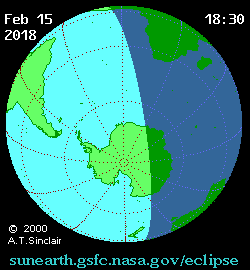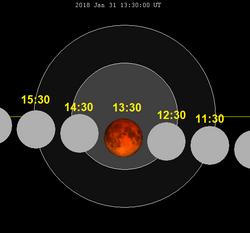| Partial eclipse | |
 From Olivos, Buenos Aires, Argentina | |
| Gamma | −1.2116 |
|---|---|
| Magnitude | 0.5991 |
| Maximum eclipse | |
| Coordinates | 71°00′S0°36′E / 71°S 0.6°E |
| Times (UTC) | |
| Greatest eclipse | 20:52:33 |
| References | |
| Saros | 150 (17 of 71) |
| Catalog # (SE5000) | 9547 |
A partial solar eclipse occurred at the Moon's descending node of orbit on Thursday, February 15, 2018, [1] [2] [3] [4] with a magnitude of 0.5991. A solar eclipse occurs when the Moon passes between Earth and the Sun, thereby totally or partly obscuring the image of the Sun for a viewer on Earth. A partial solar eclipse occurs in the polar regions of the Earth when the center of the Moon's shadow misses the Earth.
Contents
- Images
- Gallery
- Eclipse timing
- Places experiencing partial eclipse
- Eclipse details
- Eclipse season
- Related eclipses
- Eclipses in 2018
- Metonic
- Tzolkinex
- Half-Saros
- Tritos
- Solar Saros 150
- Inex
- Triad
- Solar eclipses of 2015–2018
- Saros 150
- Metonic series
- Tritos series
- Inex series
- References
- External links
A partial eclipse was visible for parts of Antarctica and southern South America.









































































































